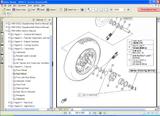firefly
Well-Known Member
OK guys I asked the dealer,the guy that prepares bikes for delivery.
" this is part of Yamaha factory PDI ( pre-delivery inspection )
Rear Axel torque for FJR, Vmax, Venture is 110 ft-Lb."
" I feel it is a little too much but this is what Yamaha wants! 95 ft-lb is OK."
So this is the end of that.

what a damaging myth that was, people even said that this was a misprint in the service manual, NO IT IS NOT A MISPRINT this is what the manufacturer specification is!!!
I am glad I asked, but for those who want to torque 55, 35 or 25 well it is your bike do what you find fit.
I'll torque mine to 95 ft-lb!.
Ibrahim
________
halfbaked
" this is part of Yamaha factory PDI ( pre-delivery inspection )
Rear Axel torque for FJR, Vmax, Venture is 110 ft-Lb."
" I feel it is a little too much but this is what Yamaha wants! 95 ft-lb is OK."
So this is the end of that.

what a damaging myth that was, people even said that this was a misprint in the service manual, NO IT IS NOT A MISPRINT this is what the manufacturer specification is!!!
I am glad I asked, but for those who want to torque 55, 35 or 25 well it is your bike do what you find fit.
I'll torque mine to 95 ft-lb!.
Ibrahim
________
halfbaked
Last edited:








































![Bovemanx Motorcycle Phone Mount Holder, [150mph Wind Anti-Shake][7.2inch Big Phone Friendly] Bike Phone Holder, Motorcycle Handlebar Cell Phone Clamp, Compatible with iPhone 16 Pro Max Smartphones](https://m.media-amazon.com/images/I/51F+1sontPL._SL500_.jpg)




